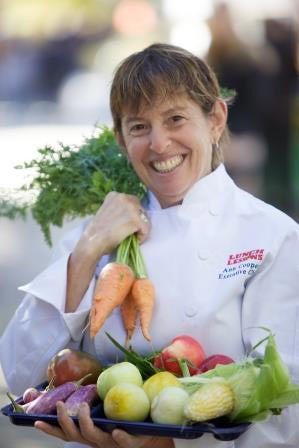In a nation where kids have shorter estimated life expectancies than their parents due to diet-related diseases, Ann is championing school food reform as a way to improve childhood nutrition.
In 2013 alone, 30.7 million children ate school lunch every day, totaling almost 5.1 billion lunches. Current lunch offerings include foods that hardly classify as healthy, often containing preservatives, excessive sugar, and other chemicals.
Chef Ann's charge is to provide the tools to help schools serve healthy and delicious made-from-scratch meals using fresh, whole foods -- and her mission to change dietary habits at the school level is proving to have a dramatic, and lasting effect on our children’s health.
By staying persistent and motivated, Ann has implemented better foods into over 60 schools. Her story shows us the power of not giving up.


From Celebrity Chef to Renegade Lunch Lady
Ann's passion for healthy school foods has taken a circuitous route. She began her career as a white-tablecloth “celebrity chef," and admittedly did not think much of our nation's school lunches until one chance encounter.
It was at the encouragement of Courtney Ross, the founder of Ross School in New York, that Ann became the Executive Chef and Director of Wellness and Nutrition at the school.
Ann was forced to learn the public school food system from the ground up, and experienced first hand the disastrous effects of unhealthy eating. Viewing the lunchroom as a teaching environment, and through introducing children to healthy, wholesome foods, Ann, now known as the “Renegade Lunch Lady,” advocates for what she considers to be a social justice issue.
She has since founded the Chef Ann Foundation, a nonprofit focusing on solutions to the school food crisis, and has received wide acclaim by Michele Obama, The New York Times, The New Yorker, Washington Post, Newsweek, Chicago Tribune, and Time magazine.

How to Change America's Health, One School at a Time
Ann cites her persistence for helping to enact change, and explains some of the challenges she faces each time she enters a new school system:
“In each school district you go into, you’re going to face five major problems: food, finance, facilities, human resources, and marketing. They’re all important, but you have to figure out which of those issues is most relevant wherever you are.”
The five main factors they consider:
- Food: Ann and her team have to evaluate what changes need to be made to the food itself. What is currently being served and what needs to change? How hard or expensive is it going to be to get the necessary ingredients?
- Finance: They have to evaluate how much money the school has, and how they are going to be able to come up with a budget and fundraising plan that will allow them to fund the program. They also have to look at what inefficiencies in the system can be minimized to reduce costs.
- Facilities: Ann has to determine whether the schools’ kitchens are equipped with what the lunch staff need to serve good, nutritious food.
- Human Resources: Ann and her team must train the staff how to prepare and serve nutritious food, and how to reduce inefficiencies. They may also have to change the hours of the kitchen staff or the number of staff employed.
- Marketing: They must keep everyone - students, parents, teachers, administrators, kitchen staff - interested and invested in the program, and by buying-in, committed to keeping it going.

Communication is Key
The Chef Ann team caters their approach to the unique needs of each school district. They have to assess the aforementioned factors to develop a strategic plan that masterfully balances each issue simultaneously.
Ann notes how one of her toughest challenges is marketing and education,
“In order to make the program work, you really have to market to parents, kids, school board members, and even your own employees. And you have to continue marketing and working every single day.”
Getting buy-in, instilling belief, and repetition of purpose have proven to be key pillars for their work. Each year, they organize upwards of 200 events, and in each instance communication is a priority; If the people involved do not believe in the change, they have found it is going to be nearly impossible to maintain the change.


Ann’s hard work and her persistence is paying off. In the Boulder Valley School District in Colorado, where she began working in 2009, school lunches have improved dramatically:
- Now, instead of being served highly processed and unhealthy entrees, snack foods, and desserts, students in every school in the district have access to fresh fruits and vegetables, and much healthier entrees.
- Every school now has a salad bar.
- The food program is more efficient overall.
- The kitchen staff is better trained, and the menus are much more nutritious.
- In just three years, Ann increased participation in the program by 16%.

Staying Motivated in the Midst of Challenges
Creating systemic change is hard. So how does she keep motivated?
Ann shared that, for her, seeing kids eat good foods -- witnessing that her work is actually making a difference -- is what keeps her going. But beyond this, Ann believes in the importance of being self-driven.
She explained,
“Motivation comes from passion. If you’re really passionate about something, if you really truly care about something in your heart, then you’re self-motivated.”
Ann’s passion for bringing better food to schools across the country has powered her through the various challenges and difficulties that she’s faced when revamping school food programs.

Want to Get Involved?
If you’re inspired by Ann’s cause and want to help support better food in schools, there are a number of things you can do:
- Visit the Chef Ann Foundation website and donate to the cause, or host fundraiser.
- Promote healthy food for kids in your own community.
- Learn more about the issue.
- Share the information with others!





